Cara Gilger's Blog, page 11
January 15, 2020
12 Books to Look Forward to in 2020
This year I am anticipating several new releases (while still tackling the books I didn’t get to in 2019 that I would still like to read). I talked about it on Instagram, but one of the things I am re-committing to is reading authors of color, non-gender binary authors, female authors and authors translated to English. If we read to expand our imagination for what is possible in the world, then we limit our own imaginations when we read only the white authors whose works are given the most attention and marketing resources by publishers. I am excited that this read brings several second books from debut authors I enjoyed in years past as well as a few new authors. While mostly fiction, this list also has a few non-fiction and poetry mixed in.
 The Vanishing Half by Brit Barrett
The Vanishing Half by Brit Barrett I loved Barrett’s debut novel The Mothers so I am incredibly excited to see her release a new work this year. The Vanishing Half follows twin sisters as they try to escape their small southern town, eventually taking up lives in two very separate worlds. Despite the lies and miles that separate them in adulthood, the Vignes sisters are still intertwined.
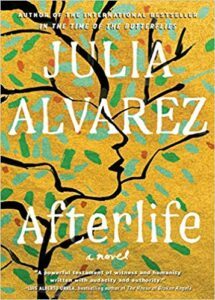 Afterlife by Julia Alvarez
Afterlife by Julia Alvarez Antonia Vega just retired from the university where she taught English, unexpectedly widowed when her sister disappears and a pregnant stranger shows up at her door. Afterlife might be the one novel I am most looking forward to this year with its wrestling with the question-how do we maintain our faith in one another and the world?
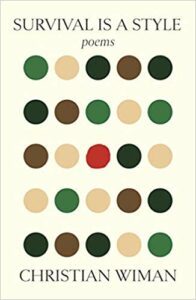 Survival is a Style: Poems by Christian Weiman
Survival is a Style: Poems by Christian WeimanChristian Weiman has been a favorite poet of mine for many years so I was delighted to see that he is releasing a new volume of poetry in 2020. Survival is a Style is sure to deliver the thoughtful reflection on faith and give glimpses of his west Texas terrain that I have grown to love.
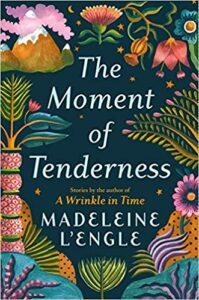 The Moment of Tenderness by Madeleine L’Engle
The Moment of Tenderness by Madeleine L’Engle From the author of A Wrinkle in Time this collection of short stories features L’Engle’s early writing. If the rest of her work is any indication, The Moment of Tenderness will deliver the tenderness, insight and honesty we have grown to expect from L’Engle.
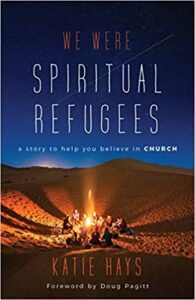 We Were Spiritual Refugees by Katie Hays
We Were Spiritual Refugees by Katie HaysI had the chance to read an ARC of this book last fall and I am thoroughly looking forward to its release. We Were Spiritual Refugees finds that perfect balance between funny and honest narrative and honest to goodness helpful information.
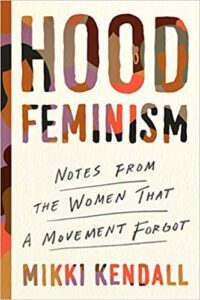 Hood Feminism: Notes from the Women that a Movement Forgot by Mikki Kendall
Hood Feminism: Notes from the Women that a Movement Forgot by Mikki Kendall A commitment to anti-racism work means listening to and understanding the critiques of your own point of view. In Hood Feminism Kendall offers an insightful critique of a movement that has focused on increasing the privilege of the few, while ignoring the survival of many.
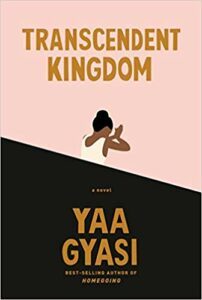 Transcendent Kingdom by Yaa Gyasi
Transcendent Kingdom by Yaa Gyasi This is another book that I can hardly wait to read. Gyasi’s Homegoing was sweeping and engaging, one of my favorite reads of the past decade. Transcendent Kingdom is a deeply moving portrait of a family of Ghanaian immigrants ravaged by depression and addiction and grief–a novel about faith, science, religion, love.
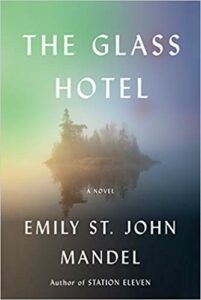 The Glass Hotel by Emily St John Mandel
The Glass Hotel by Emily St John MandelStation Eleven was a unique and creative take on the post-apocalyptic genre that wove multiple storylines into a moving reflection on community, family and the power of story. So there’s great anticipation for The Glass Hotel, Mandel’s follow up novel weaving multiple story lines into a tale on crisis and survival in the upper echelons of society.
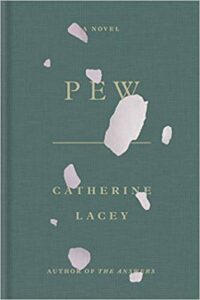 Pew by Catherine Lacey
Pew by Catherine LaceyI love a book that wrestles with faith in community, so I am anticipating Cathrerine Lacey’s Pew. A figure with no discernible racial or gender identity appears in a small, religious town, throwing its inhabitants into a frenzy.
 The New Wilderness by Diane Cook
The New Wilderness by Diane CookThe debut novel of Diane Cook The New Wilderness explores the mother-daughter relationship in the midst of climate crisis promises all the things I love in a novel of this type–family bonds, cross country pilgrimage and survivalist skills.
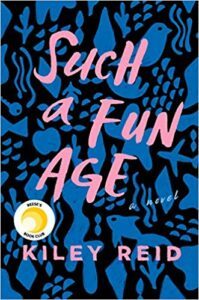 Such a Fun Age by Kiley Reid
Such a Fun Age by Kiley Reid Released at the first of the year to a splash of praise as the new millennial voice in fiction, Kiley Reid tackles race and privilege with humor and sharpness in her debut novel Such a Fun Age. I have this one on hold at my favorite local bookstore to pick up this weekend.
 The House in the Cerulean Sea by T.J. Klune
The House in the Cerulean Sea by T.J. Klune Linus Baker is a by-the-book case worker in the Department in Charge of Magical Youth. He’s tasked with determining whether six dangerous magical children are likely to bring about the end of the world. The House in the Cerulean Sea promises Umbrella Academy vibes and I am here for it.
Are there any books that caught your eye or you were already anticipating? I would love to know!
Like what you’ve read? Want more? Sign up for my twice a month newsletter (because we’re not spammy) and get original content you can’t find here on the blog. Reflections on faith and living, book recommendations and other good, nerdy fun. Sign up HERE.
January 13, 2020
A Single Word for 2020
In 2002 I was living in a small apartment on the west side of Fort Worth supporting myself. In an absentminded moment I had left my monthly tuition bill laying on the desk where I worked as a receptionist part time for one of the women I worked with to see. I knew I was in trouble when she exclaimed “Good God! That’s more than our mortgage and my husband and I are two working professionals!” Then watching the reality slide across her face she whispered “You’re paying this and your rent each month?” I nodded shamefully.
Not only was I a 20 hour a week receptionist at a church, I held a ministry internship, ran a house and dog sitting business with upwards of fifteen clients, waited tables at a chain restaurant most nights and doubles on weekends negotiating the cocktail waitress shifts whenever I thought the patrons would be drunkest and the tips would be highest. And I was in school full time preparing for ministry. I don’t remember much about that year and if I am honest, either of the adjacent years. I learned how to rotate bills, how to squeeze one more job in, how to feed yourself on $40 a week often living on dinner rolls and the kids menu which was free to employees where I waitressed. I did it. I graduated. I went to grad school. And I promised myself that the determination and fierceness I had mustered would pay off.
In 2011 at 8 months pregnant, my partner was transferred to Dallas for work. A blessed relief from him commuting to three major US cities the majority of the work weeks. I had just spent the past three years serving a church in transition from one site to two worship sites, growing by forty percent in mere months–the work had been invigorating and exhilarating but I was also exhausted. In a housing market still sluggish from the financial collapse of 2008, with 14 inches of snow on the ground the week after New Year we managed to sell out perfect little first home.
Between calls to the realtor, moving company and still working at the church, I called my mentor at the time to apprise him of the rapidly changing terrain of my circumstances. Worried about the strain of a move on my pregnancy, but equally fearful of the strain of a 70 hour ministry work week on my impending motherhood, unsure of what would be next in my vocation or really, my life, I told him about our move cross country to Texas. He said “I am not worried about you. You are one of the most resilient people I’ve met. I have no doubt you will be able to handle whatever comes next.” I felt a sense of relief wash over me. I was resilient and I did have the tools to make whatever came next work.
In 2017 I left a ministry that I loved but that had broken my heart. I was exhausted from using my vacation days to care for my child in the cardiac ICU and attend doctors visits instead of traveling or spending time with my small children and traveling spouse. My salary was barely able to cover childcare in our city and I was tired from the constant juggling of daycare and babysitters. The week after my last Sunday, I bought a little plastic pool from Walmart for the backyard, filled it with water for the girls to play in. I spent the summer alternating between reading novels and staring at the fence feet soaking in the little pool as the girls splashed and squealed with delight. My partner and I had held my daughter’s hand as she had faced her mortality not once but three times. I could feel everything that had taken in my bones.
By the time summer rolled into fall I had come to terms with the fact that I was burned out. Maybe something more than burnout…I was heartsick somehow from the sheer cost of my momentum. I was living a life carved from determination and will. Focused I had tackled every obstacle I had encountered or created. But something was wrong now; something was broken in me. Resilience as it turns out is helpful for a season of endurance, but no way to live a life.
It was that winter that I decided to choose a word that would help me grow. Not in a self-improvement way. Not to continue pushing myself to one accomplishment after another, climbing over and pushing past one obstacle after another. A word that would undo the small tendrils of resilience that were slowly suffocating me. A word that would challenge me to see my world and my life the way that God does. As a gift. A word that would soften what had hardened in me just to survive.
Joy. That is the word I picked.
I wanted to foster more joy in my life. More laughter, more playfulness, more jokes and lightness. More 80’s dance parties in the kitchen with my girls. More games of tag at the park. I wanted joy. I wanted joy becuase what the poet Ross Gay says “we know joy not becuase we know ease but because we are all going to die” is true. In a world in which you do not know how many days you have or what the shape of those days will take–why not foster joy in the face of all that uncertainty?
To say that practicing joy changed me would cheapen my experience with the cliche. Practicing joy cracked open my heart, changed my relationships, deepened my sense of gratitude for the small wonders and everyday miracles in my life.
Since that winter three years ago I have chosen a word to guide my year. In the Christian faith we call these “star words” because like the wisemen who followed the star to the Christ child, a star word is made to guide you closer to Christ as you make the year’s journey. Each year I choose my word by praying and asking:
How do I need to grow?
What do I need to work on?
Who did God create me to be?
What might guide me closer to who God is calling me to be?
What might give me healing so that I might be a part of God’s healing presence in the world?
I pray. I listen to what God is doing in my spirit and I wait until the word emerges.
Usually when it emerges I am unsurprised because it is something God was already working in me. This year when I shared my word with a friend she said “that makes sense, I already hear you wrestling with that in your writing and in our conversations.”
Your word should not be a source of shame. God does not want to shame you. Your word should not be about producing more. God does not want your productivity, God wants your heart. Your word doesn’t need to be about hustle or #goals (but it’s ok is it is). Remember, the word you choose is about connecting to your spirit who God created you to be.
This year I am cultivating tenderness. That’s my word–tenderness. I am fierce and resilient, yes, but balancing that is a softer part of my spirit I am hoping to cultivate.
Do you choose a star word? What is it this year?
Like what you’ve read? Want more? Sign up for my twice a month newsletter (because we’re not spammy) and get original content you can’t find here on the blog. Reflections on faith and living, book recommendations and other good, nerdy fun. Sign up HERE.
December 31, 2019
The Year by Ella Wheeler Wilcox
What can be said in New Year rhymes,
That’s not been said a thousand times?
The new years come, the old years go,
We know we dream, we dream we know.
We rise up laughing with the light,
We lie down weeping with the night.
We hug the world until it stings,
We curse it then and sigh for wings.
We live, we love, we woo, we wed,
We wreathe our brides, we sheet our dead.
We laugh, we weep, we hope, we fear,
And that’s the burden of the year.
December 30, 2019
Top 10 Books of 2019
This year in books covered some broad territory–I finally picked up Stephen King, I read several theology books for a cohort group, I continued my third year with my Book of the Month subscription and began research for my writing project. I thought it would be fun to share what my top ten favorite book were from this year of reading and share briefly why I loved them.
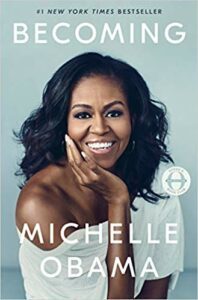 Becoming by Michelle Obama
Becoming by Michelle ObamaTechnically this book released last year and I started to read it then…but it was too real, too relevant. I had to set it down. I picked it up again and finished it this year. There are hardly words to describe how thoughtful, kind and inspiring Michelle Obama’s story of becoming the first (black) lady of the United States is for me.
 The Lightest Object in the Universe by Kimi Eisle
The Lightest Object in the Universe by Kimi Eisle I read four (!) post-apocalyptic books this year. This one sets itself apart from the genre as it casts a vision of humanity’s post-capitalism future that is complex but hopeful. I loved it so much I did something I rarely do–I wrote a stand alone review!
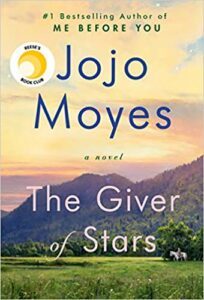 The Giver of Stars by Jojo Moyes
The Giver of Stars by Jojo Moyes Historical fiction about distributing books through rural Kentucky during the Great Depression?! Yes, please. Strong female lead and well-written and nuanced relationships? Absolutely. The Giver of Stars was a stand out of the historical fiction I read this year.
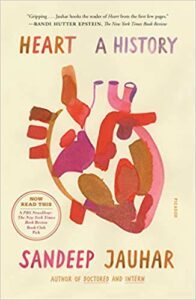 Heart: A History by Sandeep Juahar
Heart: A History by Sandeep JuaharA stand out for the concise presentation of the scientific developments in modern heart surgery balanced with a thoughtful personal narrative. This book was part of my research but beyond being informative, it was well written and enjoyable.
 Catch and Kill by Rowan Farrow
Catch and Kill by Rowan Farrow The subject matter of this book is brutal, telling the story of the serial sexual assaults of Harvey Wienstien and the attempts NBC Universal made to bury the story Farrow was working on. Difficult to read, but necessary to understand how men with power will go to great length to protect one another’s right to harass, assault and harm the women they work with. I wrote about how Farrow’s book relates to the church if you are passionate about creating spaces that are safe for people to encounter God.
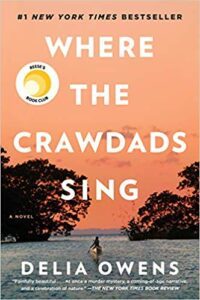 Where the Crawdads Sing by Delia Owens
Where the Crawdads Sing by Delia Owens I am generally apprehensive about books that land on the NYTimes Bestseller list, which is why it took me a while to get to this one. I heard an interview where Owens said “I write about loneliness so well, because I have known loneliness.” That was it for me. Besides a driving plot and memorable characters, Owens ability to write about loneliness makes it so palatable it feels like its own character–pressing and driving the protagonist.
 Eleanor Oliphant is Completely Fine by Gail Honeyman
Eleanor Oliphant is Completely Fine by Gail Honeyman Don’t ask me what I expected from this book–something light? Funny? Instead Honeyman dishes up a charming and heartbreaking read about trauma, friendship and healing in Eleanor Oliphant is Completely Fine.
 Grief Works: Stories of Life, Death and Surviving by Julia Samuels
Grief Works: Stories of Life, Death and Surviving by Julia Samuels Another book that I read for my research project but found personally edifying and helpful. Grief Works is the book I wish existed when I was in full time congregational work. The book that I would keep multiple copies of sitting in my church office to give to people who are looking for a resource on grief. I will be buying and handing out copies for a long time.
 The Dearly Beloved by Cara Wall
The Dearly Beloved by Cara Wall In all my years of reading I have never fallen in love with a book based off the blurb in the front jacket or cried during the prologue. The Dearly Beloved follows two couples in ministry as they negotiate their faith, marriage and friendship. Wall delivers a book that is tender without being saccharin or sentimental, thoughtful without being preachy. This may be one of my favorite books ever.
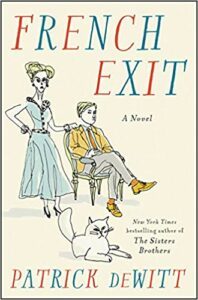 French Exit by Patrick DeWitt
French Exit by Patrick DeWitt Another backlist book, I was recommended this one by a bookseller in London when I mentioned that I love Marie Semple for her dark humor and absurd (but too real) characters. It goes to show that your local bookstore is the best place to get recommendations. French Exit is a dark comedy had me laughing out loud. I wish writers created more works like French Exit because they are a delight.
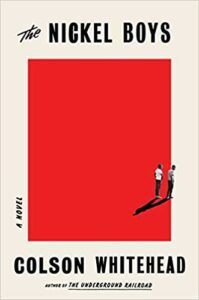 The Nickel Boys by Colson Whitehead
The Nickel Boys by Colson WhiteheadThis book was not fun, but it is an important read. We read for lots of reasons–for adventure, perspective, to feel good–but I find it important to read to be made uncomfortable, to think, to know things that are easier to not know. The Nickel Boys tells the story of Elwood who is sentenced to the brutal childrens prison in Florida after hitching a ride in the wrong car on his first day of community college.
I would love to hear what books inspired and challenged you this year.
Like what you’ve read? Want more? Sign up for my twice a month newsletter (because we’re not spammy) and get original content you can’t find here on the blog. Reflections on faith and living, book recommendations and other good, nerdy fun. Sign up HERE.
December 18, 2019
Favorite Reads of the Last Decade
I was the child in trouble for sneaking off into corners of the house with my nose stuck in a book. I read to travel to new places in time and space. I read to learn about a topic, perspective or experience that doesn’t come naturally to me or is part of my own limited experience. I read to grow, to explore. And I read because damn it, I just love reading. This decade in reading has been broad (near as I can guess I’ve read around 350 books) and rich. I thought I would pull a few of my favorites from this decade of reading into a short list with a few thoughts on why I loved them.
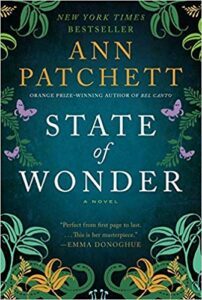 State of Wonder by Ann Pachett (2011)
State of Wonder by Ann Pachett (2011) I find Pachett books hit or miss maybe because I compare all of them to this adventure of a couple of female scientist in the jungle working on cutting edge research. The relationships are touching and complex. There are ethical dilemmas that make you think and it keeps an adventuresome pace.
 The Shallows: What the Internet is Doing to Our Brains by Nicholas Carr (2011)
The Shallows: What the Internet is Doing to Our Brains by Nicholas Carr (2011)This book deeply influenced how I interact with social media, my phone and technology over all for the past decade. Carr argues (with scientific research) that while our brains are moldable (like plastic) they are not elastic (they can’t snap back in a previous state) and hence we need to be careful how we let the internet shape our brain towards short term stimulus. Definitely still a very relevant read.
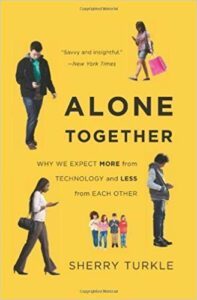 Alone Together: Why We Expect More From Technology and Less from Each Other by Sherry Turkle (2011)
Alone Together: Why We Expect More From Technology and Less from Each Other by Sherry Turkle (2011) I read this one within months of The Shallows so it’s hard for me to think about them separately (they make great conversation partners) but this book also shaped how I chose to interacte with technology over the past decade. Turkle makes the argument that we settle for close approximations of actual relationship online and since they aren’t the real deal (rich, nuanced, IRL relationships) they leave us unsatisfied. Over the last decade as social media has grown, it’s helped me prioritized IRL friendships and not get sucked into the dissatisfaction of online social connection.
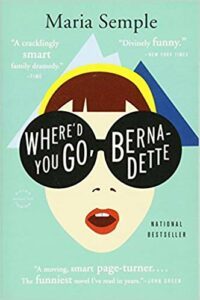 Where’d You Go Bernadette? By Maria Semple (2012)
Where’d You Go Bernadette? By Maria Semple (2012) This book came along at exactly the right time, as I was reshaping my life to accomodate my new role of motherhood. Bernadette Fox was a renowned architect known for innovative and visionary work until she suddenly disappears from the public eye. Twenty years later she’s a mom in Seattle and a menace to her neighbors living a giant run down home. I love this funny, quirky book about meaning, creativity, motherhood and purpose.
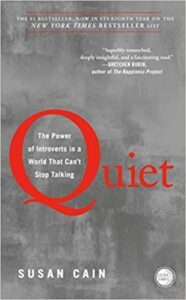 Quiet: The Power of Introverts in a World that Can’t Stop Talking by Susan Cain (2013)
Quiet: The Power of Introverts in a World that Can’t Stop Talking by Susan Cain (2013) Quiet changed how I lead meetings and work with groups of people in my ministry…and later how I understood my role as a parent. Susan Cain offers an insightful critique of our culture that centers around and rewards extroversion. It also provided helpful personal illumination as to why certain situations left me feeling exhausted.
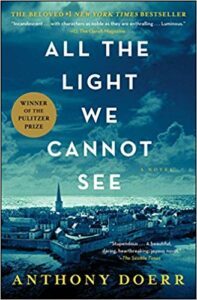 All the Light We Cannot See by Anthony Doerr (2014)
All the Light We Cannot See by Anthony Doerr (2014)Historical fiction when done well can be imaginative and challenging, touching and sharp. Doerr pulls together the story of Marie-Laure a blind girl exiled from Paris to the walled town of Saint-Malo and Werner an orphan gifted with the ability to repair radios and all sorts of communication devices as they navigate WWII.
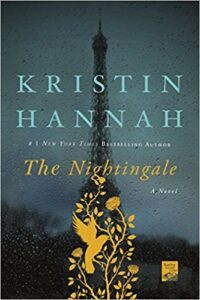 The Nightingale by Kristin Hannah (2015)
The Nightingale by Kristin Hannah (2015) Kristin Hannah has such a strong sense of place in each of her books and the ability to create strong female characters like no one else. This was my first Kristin Hannah book and I found it exciting and compelling following two women and the decision they made during German occupied WWII. It also opened up a world to all her other books.
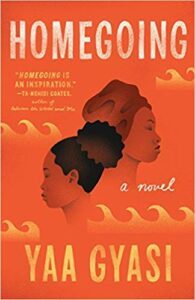 Homegoing by Yaa Gyasi (2016)
Homegoing by Yaa Gyasi (2016) Homegoing is not just a good read, it’s an important book. Gyasi’s tale of two families spans centuries drawing a clear and poingant line from the American trans Atlantic slave trade to modern racism and how it shaped each generation’s inheritance, possibilities and dreams.
 A Gentleman in Moscow by Amor Towles (2016)
A Gentleman in Moscow by Amor Towles (2016) Count Alexander Rostov is sentenced to live out his life in the Metropol hotel across the street from the Kremlin and so begins a story that spans the decades of change in Russia and how Rostov lives his life confined to a building filled with interesting characters. I love a multi-decade story of relationship and politics, this one was a stand out.
 The Power by Naomi Alderman (2016)
The Power by Naomi Alderman (2016) This post-patriarchy sci-fi imagines a world in which women develop a power that suddenly gives them the opportunity to be the dominate sex. I think about the themes of this book frequently particularly the larger questions about whether power in anyone’s hands can be used sole for good, or if it ultimately corrupts?
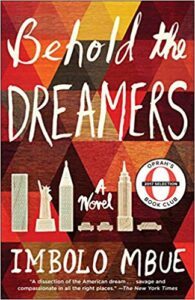 Behold the Dreamers by Imbolo Mbue (2017)
Behold the Dreamers by Imbolo Mbue (2017)A captivating look at immigration, class, race and the struggle to achieve the American Dream, Behold the Dreamers follows Jende, his wife and six year old son as they try to make a life in Harlem and become casualties of the decisions of the wealthy who brought about the 2008 crash. A great cross section of multiple issues and memorable characters.
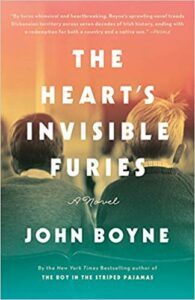 The Hearts Invisible Furies by John Boyne (2017)
The Hearts Invisible Furies by John Boyne (2017) One of my favorite books of all time, The Heart’s Invisible Furies is a coming of age story of Cyril Avery the adopted son of a wealthy and eccentric couple in 1940’s in Dublin. It’s a story of identity and meaning, self-discovery and love. I laughed, I cried, I absolutely will re-read this 500+ page tome in the next decade because it was a delight.
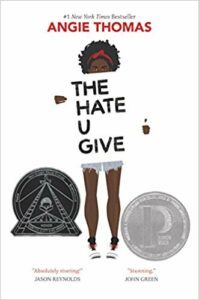 The Hate U Give by Angie Thomas (2017)
The Hate U Give by Angie Thomas (2017) YA fiction often gets treated as a second tier of fiction, or fiction’s silly little cousin but Thomas’s debut novel shows that YA can tackle bold, relevant topics. The Hate U Give tackles the topic of police shooting in the black community and is one of the more important books released in the last year. Not only was it adapted into a film but it’s been assigned in schools and become an entry point for people to wrestle with issues of justice, race, police violence and class.
 Sing, Unburied, Sing by Jesmyn Ward (2017)
Sing, Unburied, Sing by Jesmyn Ward (2017)Beautiful and poignant, this novel evokes the magical realism of Toni Morrison’s Beloved as we follow thirteen year old Jojo as he wrestles with his identity and place in the world. His mom is unfocused, his father is being released from prison and his grandfather is aging. I was challenged by Jojo’s family while still rooting for him.
 White Fragility: Why It’s so Hard for White People to Talk About Racism by Robin DiAngelo (2018)
White Fragility: Why It’s so Hard for White People to Talk About Racism by Robin DiAngelo (2018) I read this book with a reading group hosted by a black clergy woman in my area. I found reading it with other people helpful accountability to tackle the difficult topic of racism. It gave me helpful framing and language and actionable suggestions. This is a must read if you are committed to anti-racism work and an important read if you have ever said “but I’m not racist.”
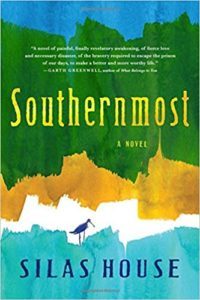 Southernmost by Silas House (2018)
Southernmost by Silas House (2018) A minister whose theological crisis spins in to a personal crisis, Silas House delivers a captivating story of faith and family. I love the way House creates a protagonist and plot that makes an argument for allowing questions rather than answers to shape a person’s faith and living.
 Heart: A History by Sandeep Jauhar (2018)
Heart: A History by Sandeep Jauhar (2018) I read this book for my own book research but it ended up being one of my favorite books of the decade. Jauhar tells a brief and accessible history of the modern developments in heart surgery–from closing holes in the heart, to the heart and lung bypass machine to the pacemaker. Peppered in Jauhar includes his own development as a doctor, which grounds the science in the stakes of practicing excellent medicine.
 Catch and Kill: Spies, Lies and a Conspiracy to Protect Predators by Rowan Farrow (2019)
Catch and Kill: Spies, Lies and a Conspiracy to Protect Predators by Rowan Farrow (2019) One of two books on the breaking of the #MeToo movement, this follows the story of Farrow’s reporting on Harvey Wienstien, NBC, Matt Laurer and the massive and elaborate cover up of men who abuse women. You really can’t talk about the last decade without talking about this movement and its impact on every industry. There were lots of applicable lessons for the church and you can read them here.
 The Lightest Object in the Universe by Kimi Eisele (2019)
The Lightest Object in the Universe by Kimi Eisele (2019) This book could easily be overlooked for its simplicity, but I loved the way Eisele tells the story of the end of the world as one filled with hope, imagination and relationship. There is a vision for who humans could be in the apocalypse that challenge readers to live into that vision now. I loved this book enough I wrote a full review you can read here.
 The Dearly Beloved by Cara Wall (2019)
The Dearly Beloved by Cara Wall (2019) The Dearly Beloved follows James and Nan and Charles and Lily, over their decades in ministry and friendship. Neither sentimental or cynical, Wall tells a thoughtful story about ministry, marriage and friendship with lyrical prose and thoughtful observation about the complexities and nuances of shared life.
One of the things I noticed pulling this list together is that 2016 and 2017 produced some of the most powerful and influential books I read this decade. I didn’t read any more or less that year than I usually do, but for some reason those years produced impactful reads. I am so curious–what made your list? What should I read that I didn’t get to this decade? Let me know!
Like what you’ve read? Want more? Sign up for my twice a month newsletter (because we’re not spammy) and get original content you can’t find here on the blog. Reflections on faith and living, book recommendations and other good, nerdy fun. Sign up HERE.
December 3, 2019
We Need to Tell You Something…
So I need to tell you something…something that if we’ve seen each other in person in the last four years you probably already know. We haven’t kept it a secret, in fact our family talks about it openly and honestly. At the same time we’ve made the intentional choice to not use this thing called the internet to tell you. We believe that relationship is best done IRL, we really dig you like that. We like seeing your face and we like it when you see our facial expressions and hear our tone of voice. We like having the conversations that really matter over a table or with a cocktail or clutching a hot cup of coffee. Especially if it’s something really important, which this one really is important.
We also know the internet is used for a lot of really beautiful connection but it can also be a space for misunderstanding. And then there’s this little thing that’s actually a big thing to us…our story is not just OURS (Tim and mine), this story belongs to our children too. And we’ve always thought that they deserved the right to choose their digital inheritance, to choose what is Google-able about them and so we’ve been mindful that only part of this story is our story. We are temporary stewards and we want to steward well.
But here’s the other thing…Our family’s story is a story shared by lots of families and yet…and yet we’ve found very few resources to help us. So I applied for a grant to research and write with the hope of creating resources for families like ours. The grant seemed like a long shot—who would support this minister/mother/writer as she explored the questions she had about trauma and grief and healing and how the church could minister better? But someone did. Someone thought that a family like ours might need more resources than the meager ones in existence.
So what is a family like ours? It’s a family that laughs at the dinner table and yells for shoes to be picked up when they are left to clutter the kitchen floor. It’s a family that loves hiking in warm weather and Thai food on a Friday night. And it’s a family who’s experienced what it’s like to have a child with a congenital heart defect. That knows the well worn phrase “we’ll wait and keep monitoring it.” We’re a family that has prayed for healing that did not come and a family for whom healing is a part of our story…just not the way we hoped. We’re a family that knows the ins and outs of a Cardiac Intensive Care Unit and has a cardiac thoracic surgeon with whom we are on a first name basis. We have known sleepless nights cradling a restless child in pain, lines connecting their small body to large beeping machines and we have known the joy of bringing our baby home from the hospital (again…and again).
We are a family for whom grief and fear have been close companions and we are a family who has known the depth of love when family and friends have set aside their own lives to care for us. We are a family that knows the sting of poor care from community and the resurrection and beauty of care from unexpected places. We know what it means down to our bones that we are not promised one single day on this earth. Not one. And we have allowed that urgency to shape our living in ways we could have never anticipated.
We still believe in IRL relationship, in fact we believe more than ever about showing up in our bodies to care for one another. But we also think that it is time to share a little more of that story and how it has challenged us in ways that felt like breaking, shaped the urgency of our living and the depth of our faith.
If you want to learn a bit about my grant and what I am working on you can check that out here. And if you want to hear how its going, I will be sharing updates from time to time in my bi-monthly newsletter.
Like what you’ve read? Want more? Sign up for my twice a month newsletter (because we’re not spammy) and get original content you can’t find here on the blog. Reflections on faith and living, book recommendations and other good, nerdy fun. Sign up HERE.
December 2, 2019
Big News!
I have this project I have been working on for months now, in the quiet early morning hours set aside for study and writing, in coffee shops and in anytime I can poke around the edges of life. It is my passion project. Perhaps you have one too and know what I am talking about but in case you haven’t found yours yet, it is the thing that I love dearly, tend to faithfully and want desperately to create for the world. A few months ago a dear friend told me about a grant that they applied to which helped them take time and space away from the immersive work of ministry to write about their passion project. So I applied. And then I forgot about it. But it turns out that someone else thinks my passion project, the one with questions and research might have the potential to help others, too.
I am incredibly honored to share that I am one of the 2020 recipients of the Louisville Institute’s Pastoral Study Program grants. The Louisville Institute offers pastoral leaders the gift of time and the resources to investigate issues related to the Christian life of faith, North American religious practices and institutions, and/or major challenges facing contemporary society.
For six months in the spring I will be taking a slower pace for my ministry as I work to research and write about grief, medical trauma and parenting. Sounds simple, right? As I am still so overwhelmed to receive such a wonderful opportunity to work publically on something I have been working on privately for several seasons, I thought it might be best to share a small excerpt from the grant for you to get a glimpse at the work I will be undertaking.
Here is an excerpt from the project in case you are into good, nerdy research that might help other people wresting with the same questions:
“The heart, both organ and metaphor, has captured the imagination of modern medicine and faith. We speak of faith as being a “matter of the heart.” We sing that God might “tune my heart to sing thy praise.” We often talk about salvation and forgiveness as “a change of heart.” However, the church has little to say to those experiencing medical trauma when this organ – this center of life – does not work as expected. This is doubly so for the fifteen thousand children born each day with a congenital heart defect. How do we construct a practical theology that ministers to families who have been through medical trauma?
As medical intervention for historically life-threatening or terminal diseases has increased, the number of people – and specifically children – who experience medical trauma and grief has increased. Perhaps the death of a child is less common, but the diagnosis and treatment of a child still remains a common and difficult experience.
American culture has become simultaneously detached from our bodies while at the same time becoming obsessed with wellness. The church has the opportunity to minister to families by breaking through this contradicting narrative, offering an alternative vision: one that fully incorporates the experience and trauma of broken bodies into an understanding of God and how we live as mortal beings in the world. The acclaimed cardiac surgical pioneer Dr C Walton Lillihei once said about the risk of his research, “You don’t venture into a wilderness expecting to find a paved road.” What if the church could create liturgy that provided trail markers to guide families through the wilderness of their child’s mortality? What if by talking more robustly about our mortality we shaped our living in light of our dying?
The question of how we minister to families and create spaces that hold their experiences of mortality and grace is central to the church as we continue to minister in an ever more technologically advanced society. It is no coincidence that, as the church struggles to be “relevant” to a new generation, our metaphors for near-death, trauma, and grief are in need of updating in these new cultural and medical realities. It is crucial for the church to offer a counter-liturgy that makes meaning of our mortality and creates a sense of embodiment, over and against the liturgies of American culture that echo prosperity theology and worship wellness.
James K.A. Smith decenters liturgy that is solely the act of thinking beings; this will play a significant role in constructing a theology and liturgy that starts from a place of embodiment. In a challenge to the church’s approach that is centered in the Descartes notion that we are primarily thinking being Smith asks “What if that is actually only a small slice of who we are? And what if that’s not even the more important part?” What we risk in avoiding these hard stories and conversations about trauma, children and suffering is avoiding the questions that really matter to a generation of families who benefit from modern medicine but often bear its invisible scars.”
I cannot wait to see what this project holds in store for my own faith and for a community of parents that I adore. If you are interested in keeping up with me during this research and writing time, I will be sharing updates from time to time in my bi-monthly newsletter and here on the blog.
December 1, 2019
Fall Reading Recap 2019
This fall was a fruitful reading season for me, covering a wide swath of topics and themes, exploring moments in history of which I possess little knowledge and pushing myself in some cases to wrap my brain around some dense but worthwhile reads. I decided that since fall covered so much ground I would divide my typical seasonal reading list into three categories–fiction, non-fiction and poetry. These are all the books I read–the good, the meh and the fabulous–so I have included a brief synopsis along with what I thought about each of them. Per usual you can take or leave me opinions (but if you want to talk about any of them I would love that!). This is the “nerdy” part of good, nerdy fun!
Fiction
 The Lightest Object in the Universe by Kimi Eisele
The Lightest Object in the Universe by Kimi EiseleI love the post-apocalyptic genre but I am picky. I really love the genre when it can point to the possibility for who people can be not only in terrible circumstances but how we could shape our world now. My favorite read so far in 2019, The Lightest Object in the Universe by Kimi Eisele delivered a vision of the future that was hopeful and thought provoking about how we could live now. I loved it so much I wrote a full review HERE.
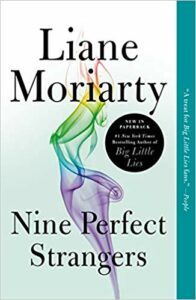 Nine Perfect Strangers by Liane Moriarty
Nine Perfect Strangers by Liane Moriarty I enjoy Liane Moriarty’s books particularly What Alice Forgot and Big Little Lies. She has a way of using multiple viewpoints to create some really sharp but well planned plot twists. However, the plot twists in Nine Perfect Strangers jumped the shark, it was so wild that it severed the relationship between the reader and the characters. Ultimately, I didn’t care how the characters ended up because the plot twist was so wild I didn’t get the sense that Moriarty cared about these characters.
 Good Morning, Midnight by Lily Brooks-Dalton
Good Morning, Midnight by Lily Brooks-DaltonOften I find my best reads by browsing my local bookstore or on the recommended of trusted bibliophile friends. However, on occasion a book will come across my feed on Instagram after the buzz of release has died down that get consistently good reviews. Good Morning, Midnight is one of those books. Since I wanted to read it during September, where I had committed to not purchasing any books, I checked out a digital copy from the library. I found this to be a delightful read and in a similar vein to Station Eleven.
 The Great Believers by Rebecca Makkai
The Great Believers by Rebecca Makkai This book wrecked me in the best possible way. It follows the story of Yale and Fiona during the early 1980’s in Chicago during the period of time that AIDS was a death sentence slowly circling the gay community and the aftermath of that time period. The complexity of characters and the moral choices they are faced in this story was beautiful and heartbreaking. If you are like me and you are just young enough that you remember AIDS after we as a culture began to seek a cure and promote public health and awareness, you need to read The Great Believers to get a solid picture of what the time before that was like for the hundreds of thousands that died.
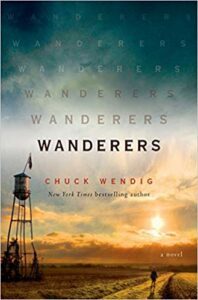 Wanderers by Chuck Windig
Wanderers by Chuck Windig I picked up Wanderers based on the synopsis and a few online reviews, an apocalyptic story that follows two strange diseases that place humanity in jeopardy. I enjoy a good apocalyptic or post-apocalyptic story and this one had a solid plot and most of the characters were worth investing in as the story unfolds. However, at nearly 800 pages I thought could have been better edited in two ways. First, too often Wendig tried to tell us how we should feel or think as the reader through the inner monologue of characters. If all of this excess explanation was edited out the book could have clocked in about 200 pages less. Second, I prefer a strongly written scene and dialogue to place me in the story, rather than being told. Sometimes I felt like rather than rewriting scenes to make them tighter and more powerful we got an inner dialogue of a character. All of that said, it was still entertaining as all get out, it was just no King’s The Stand.
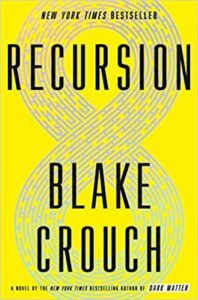 Recursion by Blake Crouch
Recursion by Blake Crouch True confession, I didn’t like Dark Matter when I read it. It wasn’t until months later when I couldn’t stop thinking about the theories he lays out that I appreciated it as a book. So when Recursion released and was offered through Book of the Month I snagged it. Crouch is a master of a very specific kind of thriller that presents complex quantum science and imagines it being used to its most terrifying end as a way to think about technology and its consequences. He also uses scientific theory to explore what grief and love will drive humans to do. One the whole I found this book suspenseful and thought provoking.
 Evvie Drake Starts Over by Linda Holmes
Evvie Drake Starts Over by Linda Holmes After reading way too much apocalyptic fiction, thrillers and one book on the AIDs epidemic I needed something light. Evvie Drake Starts Over completely fit the bill for something light and entertaining, while still having substance and thought. When former Major League pitcher, Dean Tenney, moves into an apartment at the back of Evvie’s house, the two make a deal: Dean won’t ask about Evvie’s late husband, and Evvie won’t ask about Dean’s baseball career. I enjoyed rooting for Evvie and Dean as they each figured out their own stuff, and the secondary characters were all very well written and really made the story shine.
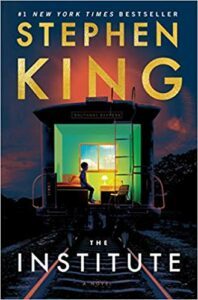 The Institute by Stephen King
The Institute by Stephen King I am a new Stephen King convert so my reviews never take into consideration the wide pantheon of his writing. In the middle of the night in a matter of minutes, Luke Ellis is kidnapped with his parents are murdered. Luke will wake up at The Institute, in a room that looks just like his own, except there’s no window. And outside his door are other doors, behind which are other kids with special talents—telekinesis and telepathy—who got to this place the same way Luke did. I enjoyed the suspense and mystery of the first two-third of The Institute as Luke and his friends try to navigate this terrifying new world. The last third though had the feel of something I had read before, like if one of Blake Crouch’s scientific thrillers made a baby with Trenton Lee Stewart’s Mysterious Benedict Society–it felt very “kids on a heist” to me. It was still an excellent book that kept me turning pages.
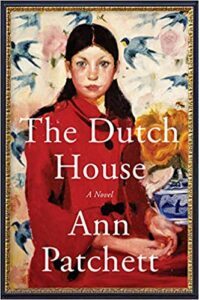 The Dutch House by Ann Patchett
The Dutch House by Ann Patchett Can you really dislike a book if you listen to the audio version and Tom Hanks is the reader? No, no you cannot. This book might have only been ok if I had read it myself but it was fabulous with Tom Hanks as the narrator. Really, he could read me the phone book and I would think it was wonderful but I digress. The Dutch House tells the tale of two siblings over the course of decades as their lives unspool after the death of their father and their stepmother evicting them from their childhood home.
 The Secrets We Kept by Lara Prescott
The Secrets We Kept by Lara Prescott I didn’t know much about this book when I picked it up–historical fiction? Cool. Strong female leads? Great. So I was pleasantly surprised to learn that The Secrets We Kept was a tale of female spies during the early Cold War era (a time period I don’t know much about). At the height of the Cold War, two secretaries are pulled out of the typing pool at the CIA and given the assignment of a lifetime. Their mission: to smuggle Doctor Zhivago out of the USSR, where no one dare publish it, and help Pasternak’s magnum opus make its way into print around the world. I loved this blend of spies, literature and history.
 The Giver of Stars by Jojo Moyes
The Giver of Stars by Jojo MoyesCan I get enough well-written fiction with strong female leads? Why no, no I cannot. Am I a sucker for a bookish plot especially on that involves creating access to books for those in rural America? Why yes, yes I am. I adore The Giver of Stars. The protagonist was complex and the cast of characters that surrounds her in this rural Kentucky mining town in the 1930’s were well developed and elements of the unexpected. I appreciated the way that Moyes creates layers of relationship that were interesting and nuanced without being complicated and overworked. Finally, I loved the sense of place that this book had in the hollers of Kentucky in the woods and mountains.
Non-Fiction
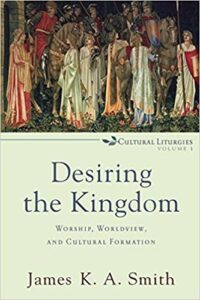 Desiring the Kingdom: Worship, Worldview and Cultural Formation by James K.A. Smith
Desiring the Kingdom: Worship, Worldview and Cultural Formation by James K.A. Smith This is going to be a book for the small slice of readers that are engaged in Christian worship and preaching. In other words, if you are a church nerd, this books was an intriguing read for several reasons. Desiring the Kingdom not only looks at what preaching and worship do or can do. The book also explores the larger shaping of people’s hearts in the face of competing practices people engage in to make meaning. I walked away with a solid philosophical framework but also some thoughtful ways to talk about Christian Education in the church and how to shift some of the practices of worship to engage the heart.
 Catch and Kill: Lies, Spies and a Conspiracy to Protect Predators by Ronan Farrow
Catch and Kill: Lies, Spies and a Conspiracy to Protect Predators by Ronan Farrow I read Catch and Kill book in 36 hours…I couldn’t put it down and I have so many thoughts coming out of it. Farrow does an excellent job presenting brutal material in a straight forward journalistic style that between that and the rigorous fact checking presents a solid case against Harvey Wiestien and NBCUniversal (they are despicable). He has a dry sense of humor and an ability to deliver a one liner that was both humorous and could cut through the bullshit. Farrows case for how nefarious and despicable HW and NBC were to preserve power and manipulate public narrative is captivating and terrifying but I found several key points in his reporting to be very applicable to church leadership and building structures of accountability that mitigate power and protect the vulnerable you can read those HERE.
 Tears We Cannot Stop: A Sermon to White America by MIchael Eric Dyson
Tears We Cannot Stop: A Sermon to White America by MIchael Eric Dyson This was another book for my study cohort and I decided that instead of reading it, since it was a sermon the best way to process the authors meaning would be to listen to it on audiobook. I appreciated Tears We Cannot Stop on a lot of levels, not just because it reminded me of the truth that there are some things that can only be communicated through a sermon. In other words, sermons exist to share things that no other form of communication can do as effectively. I also loved the hymn selections of Kendrick Lamar and Beyonce.
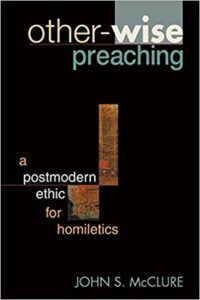 Otherwise Preaching: A Post-modern Ethic for Homiletics by John McClure
Otherwise Preaching: A Post-modern Ethic for Homiletics by John McClure
Ok, ok, ya’ll let’s get real for a second–this book is DENSE. I studied under John McClure for my master and I thought “oh, I will just do a light, quick reading of this, pick up the nuggets and call it good.” Nope. Otherwise Preaching is heavily philosophical and takes some real grey matter to get through. I am grateful that I read it with my cohort group so that I could process it in conversation and get the most out of it. I found his insight into the way the Quadrilateral has collapsed in its authority fascinating, but wanted to hear more about what’s next.
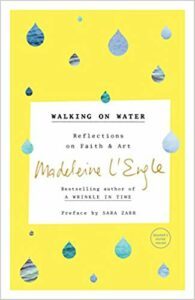 Walking on Water: Reflections on Art and Faith by Madeleine L’Engle
Walking on Water: Reflections on Art and Faith by Madeleine L’Engle This is one of those rare books that is made to savor, to be read slowly so that the richness of metaphor and abundance of imagery can be absorbed and enjoyed. Walking on Water is a reflection on faith and writing that takes seriously the work of asking better questions and exploring divine possibility.
Poetry
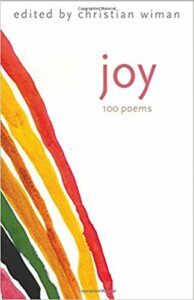 Joy: 100 Poems by Christian Wiman
Joy: 100 Poems by Christian Wiman I read this book several years ago but took it off the shelf to re-read again this year. Joy is a collection of well selected poems that speak to the nuance and intricacies of living a life. I have several favorites that I will add to my little stash of poems I am working on memorizing.
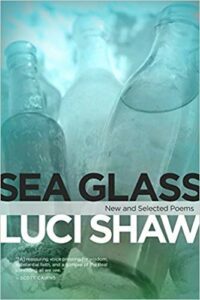 Sea Glass: New and Selected Poems by Luci Shaw
Sea Glass: New and Selected Poems by Luci ShawI am remiss to confess that I was unaware of the work of Luci Shaw until I recently attended the Walking on Water Writing Conference celebrating the life and legacy of Madeleine L’Engle. Shaw was a friend and contemporary of L’Engles and her poetry is a pleasurable touchstone of wisdom found in the ordinary. Sea Glass is a delight I haven’t experienced in a while reading poetry.
That’s my reading for the fall (September, October and November) and as always I would love to hear what you are reading and enjoying!
Like what you’ve read? Want more? Sign up for my twice a month newsletter (because we’re not spammy) and get original content you can’t find here on the blog. Reflections on faith and living, book recommendations and other good, nerdy fun. Sign up HERE.
November 6, 2019
The Facts of Life by Padraig Ó Tuama
That you were born
and you will die.
That you will sometimes love enough
and sometimes not.
That you will lie
if only to yourself.
That you will get tired.
That you will learn most from the situations
you did not choose.
That there will be some things that move you
more than you can say.
That you will live
that you must be loved.
That you will avoid questions most urgently in need of
your attention.
That you began as the fusion of a sperm and an egg
of two people who once were strangers
and may well still be.
That life isn’t fair.
That life is sometimes good
and sometimes better than good.
That life is often not so good.
That life is real
and if you can survive it, well,
survive it well
with love
and art
and meaning given
where meaning’s scarce.
That you will learn to live with regret.
That you will learn to live with respect.
That the structures that constrict you
may not be permanently constraining.
That you will probably be okay.
That you must accept change
before you die
but you will die anyway.
So you might as well live
and you might as well love.
You might as well love.
You might as well love.
25 Childrens Books for Advent and Christmas
Each year we count down the days of Advent by unwrapping a reading a book each night. While some of the books we use are fun and frivolous, we try to use these books and this time to teach the story of Advent and Christmas to our kids. We hope to offer a counter balance to the liturgy of consumerism that targets our children’s hearts this time of year. We prioritize books that have imaginative illustrations and characters who are illustrated in a way that is geographically and Biblically accurate (although we need more books that are illustrated responsibly). We also really love books that capture the story of Jesus’s birth and open up the imagination to consider other scripture passages or theological ideas, while trying to avoid books that condense the richness of the birth and teachings of Jesus into the death and resurrection. Finally, this list includes a variety of Biblically based and contemporary stories as well as hymns, as we enjoy a variety when reading a book each night as part of our Advent tradition. Below are twenty-five of our favorite children’s books for Advent (with the titles linked to find them online):
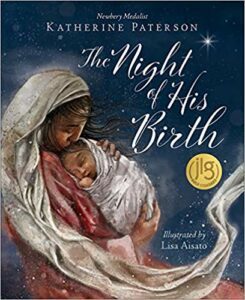 The Night of His Birth by Katherine Paterson
The Night of His Birth by Katherine Paterson The giant in children’s literature Katherine Paterson (of the award winning Bridge to Terabithia) has written and illustrated this thoughtful reflection on the nativity story. From Mary’s voice we get the concerns and hopes of a mother, but we also get some really excellent explicit theology–talking about who God is and what God is doing.
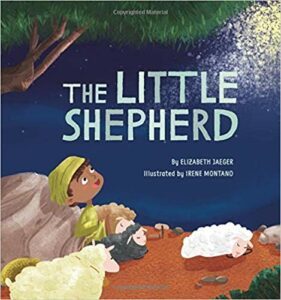 The Little Shepherd by Elizabeth Jaeger
The Little Shepherd by Elizabeth JaegerThis new release is tender and sweet and perfect for your preschooler to explore the nativity with curiosity and wonder through the eyes of a little shepherd boy. I can’t wait to share this one with my sweet little preschoolers at church as we learn the wonder of the story together.
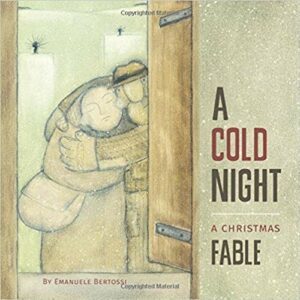 A Cold Night: A Christmas Fable by Emanuele Bertossi
A Cold Night: A Christmas Fable by Emanuele Bertossi Another new release, this book can best be described as gentle. With its soft illustrations and it’s story of animals searching for shelter from the cold, it creates a softness and wonder that draws little readers in. It is the perfect gentle read to share with your kids as you wind down for bed.
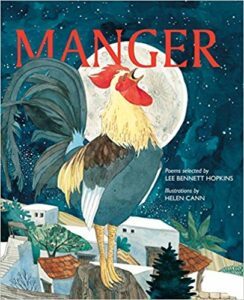 Manger edited by Lee Bennett Hopkins
Manger edited by Lee Bennett HopkinsAn unexpected gem in the pantheon of Christmas books–this is a collection of poems that tell the story of the birth of Jesus from a variety of animals. Reflecting a variety of perspectives and insights while exposing your kids to poetry–its a family fav!
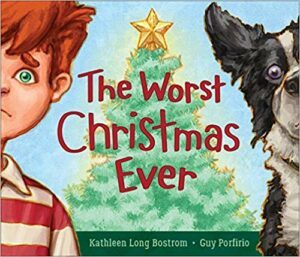 The Worst Christmas Ever by Kathleen Long Bostrom
The Worst Christmas Ever by Kathleen Long Bostrom This is a modern Christmas tale that follows a boy as his family moves to California just before Christmas, leaving him worried “what will Christmas be like with palm trees and no snow?” What I love about this book is that it covers several themes without feeling scatters. This is a great book if your Christmas looks different this year or if you have moved. I also love how attending church and being a part of a community is a part of the story. Definitely an instant favorite.
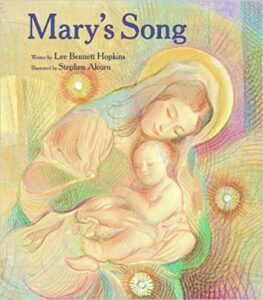 Mary’s Song by Lee Bennett Hopkins
Mary’s Song by Lee Bennett Hopkins Weaving excerpts of scripture into the narrative of Mary’s story as she prepares for Jesus, this is a gem. The illustrations are done with colored pencil in broad strokes which would make it the perfect book to pair with a “draw your own Christmas story” activity for little ones.
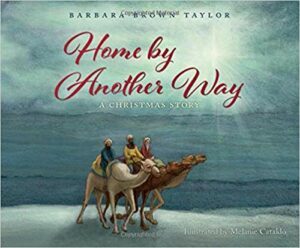 Home by Another Way: A Christmas Story by Barbara Brown Taylor
Home by Another Way: A Christmas Story by Barbara Brown Taylor Occasionally there is a children’s book that I enjoy as much if not more than my children because it reveals an interesting point of view or interpretation of the scripture. Offering a unique focus on the Three Wisemen the story doesn’t begin or end with the manger, rather tells the way the wisemen navigate the treacherous jealousy and paranoia of King Herod. A necessary addition to get a good grip on the full Christmas story.
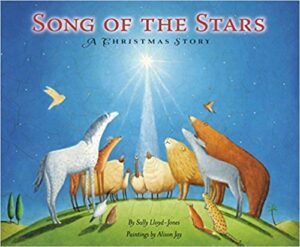 Song of the Stars: A Christmas Story by Sally Lloyd Jones
Song of the Stars: A Christmas Story by Sally Lloyd Jones “It’s time! It’s time!” the animals across the world see the star, feel the wind, hear the promise of the star and proclaim the coming of the Christ child. As they pronounce the way and celebrate the coming Christ, we journey from the dense forest to the ocean deep to experience the majesty of God’s creation.
 This is the Stable by Cynthia Cotten
This is the Stable by Cynthia CottenThere are Christmas books that set themselves above the rest with creative, breathtaking and thoughtful illustrations, this is one of those books. It begins with the star above the manger with spread wings and with each illustration of the story the wings enfold the story. The prose is beautiful and yet short, so it can hold little reader’s attention.
 Room for a Little One: A Christmas Tale by Martin Waddell
Room for a Little One: A Christmas Tale by Martin Waddell This book falls in the genre of animals welcoming Joseph, Mary and the baby into the manger. Unlike other books that portray the animals as cartoonish, this story has beautiful, soft illustrations that communicate the reverence and gentleness of the scene.
 The Jolly Christmas Postman by Alan Ahlberg
The Jolly Christmas Postman by Alan AhlbergThis is not a religious book, but I love how interactive it is and how it promotes community during a time of year when kids are tempted to think “me, me, me!” If your family does anything to spread kindness in your neighborhood this is an excellent book to talk about spreading kindness in your community.
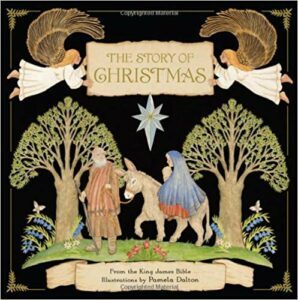 The Story of Christmas illustrated Pamela Dalton
The Story of Christmas illustrated Pamela Dalton Taken from the New King James interpretation of the Bible this tells the scripture with lovely illustrations. When my oldest was two she LOVED this book and would take it to her babysitter’s to read, who said “I’m not very good at reading old English!”
 The Twelve Days of Christmas by Laurel Long
The Twelve Days of Christmas by Laurel Long I put this one on the list for purely sentimental reasons, our little family LOVES singing this book together and I have a video of one of my kids singing the whole thing through at two years old. Aside from the sentimentality it has intricate illustrations and each previous verse is hidden within the newest verse’s illustration.
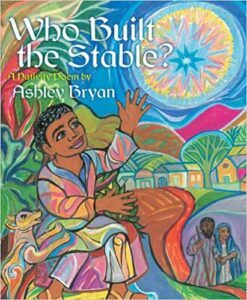 Who Built the Stable?: A Nativity Poem by Ashley Bryan
Who Built the Stable?: A Nativity Poem by Ashley Bryan We love any chance we can get to incorporate poetry into teaching faith or just reading in general (because the way poetry is taught in school–bleh! And poetry is magic). This poem about the nativity is lovely and imaginative, drawing on Latin American art and culture to capture young reader’s imagination and creating a more expansive understanding of the story.
 Christmas in the Manger by Nola Buck
Christmas in the Manger by Nola BuckThis is one of two board books on the list. It’s short, but clear and perfect for infants and toddlers to learn the Christmas story. Do I wish the humans were illustrated in a more Biblically accurate way? Yes. But that just means if you have a Christmas board book in your heart to write–pitch it and get someone who will give the holy family some melanin.
 Nativity by Cynthia Rylant
Nativity by Cynthia Rylant This is one of my favorite books on faith for children, Advent or no. We use it year round at our house as it connects the story of the nativity and birth of Jesus to the beatitudes he teaches in his Sermon on the Mount. I love the way this book decentralizes the nativity to place its importance in relationship to the ministry and teachings of love, compassion, peace making and other teachings of Jesus.
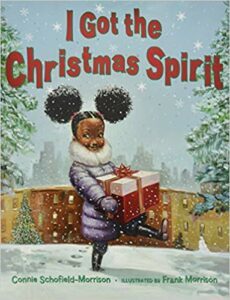 I Got the Christmas Spirit by Connie Schofield-Morrison
I Got the Christmas Spirit by Connie Schofield-MorrisonAnother modern story that captures the Christmas spirit from the perspective of a young girl, alive and energized by experiencing Christmas in her community. I have been a huge fan of Frank Morrison’s illustrations and like so much of his work this one exudes energy and joy. A great book to use with your kids to talk about family traditions, community activities and why we do what we do to experience the joy of God in the world.
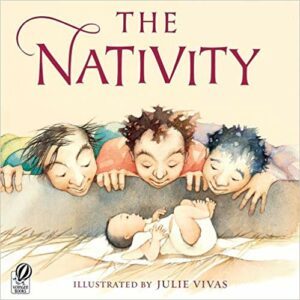 The Nativity illustrated by Julie Vivas
The Nativity illustrated by Julie VivasUniquely illustrated with characters that are painted with broad strokes that bring a sense of whimsy and joy, this book is top among my favorite. It offers a refreshing perspective and visuals in the collection of Christmas books, creating a sense of wonder and silliness without losing sight of the sacredness of the story.
 We Three Kings by Gennady Spirin
We Three Kings by Gennady Spirin This book is so fun! Our family loves to sing along together as we go through this beautifully illustrated book based around the hymn. Since we read a book a night as our Advent calendar, mixing in a few that are sing-alongs make the season fun and give us something to break up just reading.
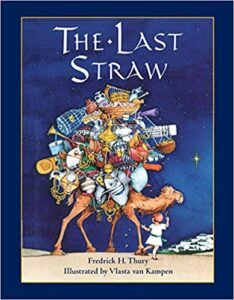 The Last Straw by Fredrick H Thury
The Last Straw by Fredrick H Thury The Last Straw tells a camel’s story as it makes the journey with the wisemen to visit Jesus. The genre of Christmas stories that are “from the camel’s perspective” are not my favorite over all but this one gives the reader a perspective on humility and service that I appreciate.
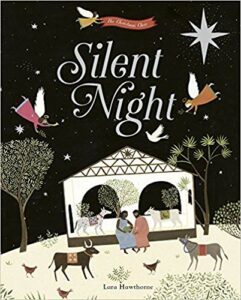 Silent Night by Lara Hawthorne
Silent Night by Lara Hawthorne A standout book that illustrates the hymn Silent Night with illustrations that both capture the stillness invoked by the song and the imagination of seeing a holy family that is illustrated in a Biblically accurate way with rich melanin. This is another book that my family loves to sing together as we turn the pages and experience the story come alive.
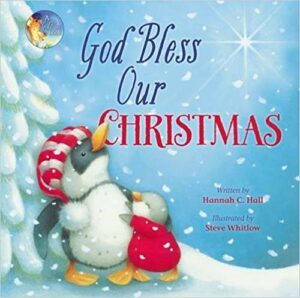 God Bless Our Christmas by Hannah C Hall
God Bless Our Christmas by Hannah C Hall This is another board book and it’s a sweet little book for infants and toddlers to introduce the different winter and seasonal activities and talk about how God works in them. My babies enjoyed this one and the cute fluffy animals.
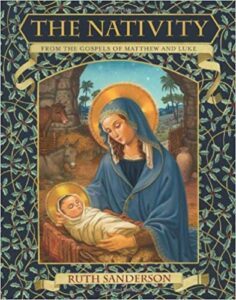 The Nativity: From the Gospel on Matthew and Luke by Ruth Sanderson
The Nativity: From the Gospel on Matthew and Luke by Ruth Sanderson Illustrated in classic European art portrayals this book blends the birth story from Matthew and Luke (yes, we blend two stories and teach them and tell them as one). What I like about it is that it doesn’t come to a conclusion at the stable but rather tells of the holy family’s migration to Egypt and Jesus continuing to grow.
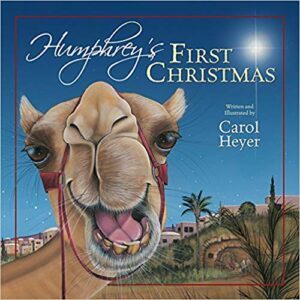 Humphrey’s First Christmas by Carol Heyer
Humphrey’s First Christmas by Carol Heyer I know I’ve already mentioned that I am on the fence about Christmas stories “from the camel’s perspective” but my kids love the story of the whiney, over dramatic Humphrey as he follows the star, eventually discovering selflessness in the Christ child.
 S is for Snowman: God’s Wintertime Alphabet by Kathy-Jo Wargin
S is for Snowman: God’s Wintertime Alphabet by Kathy-Jo WarginThis is not an explicit Christmas book but we received it as a gift many years ago and it has become a classic in our home as it goes through God’s winter wonderland talking about the traditions and rhythms of Christmas and wintertime with holy imagination.
While we have built our own family library we utilized the library for many years to supplement our library and get enough books to have an Advent calendar. Whether you use books as your Advent calendar or just pick up a few to read throughout the season I hope you enjoy the season with you little ones.
Like what you’ve read? Want more? Sign up for my twice a month newsletter (because we’re not spammy) and get original content you can’t find here on the blog. Reflections on faith and vocation, book recommendations and other good, nerdy fun. Sign up HERE.



